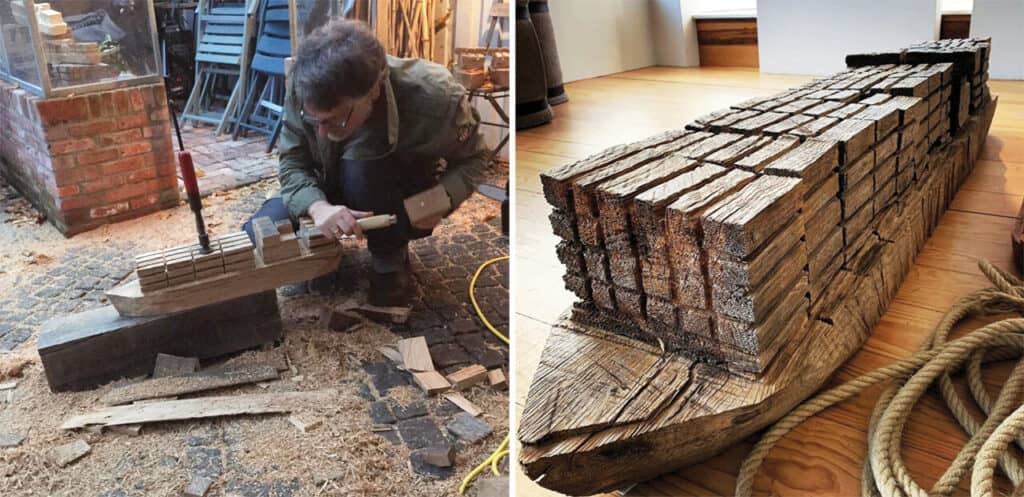During our last Coffee with… Maritta Stille from Aktion Kulturland we got to the question what the “economy” does, what companies do, or should do in terms of sustainability. That was reason enough for us to talk to someone who knows. So, despite the typical northern German weather conditions – it is grey, warm, windy – I am meeting for a Coffee with… Matthias Langenohl at the river Elbe. Our topic:
Why do companies take so long to become greener?
Matthias used to be in charge for the sustainability strategy and its implementation in a large print and media company. Today, he supports companies on that topic, helps them to become more efficient, resource- and eco-friendly. And “on the side”, he turned his whole life upside down: Away from the 50+ hour week to more freedom. With regard to his work, and his hobby: Wooden sculptures, that he crafts with a chainsaw – the “sawn freighters” (one reason why we are meeting at the Elbe).
B: We have been asking ourselves for quite some time now, why some companies are so hesitant to become “greener”. That can’t only be for economic reasons. Or do managers really only think in terms of “growth”?
M: Well, it is not that simple to answer that question. What was our trigger back then? In the 2000s “paper” was highly criticized. It was considered waste and the destroyer of forests. That was a topic that had to interest me. And it also was a question of efficiency. That is how it started: With the question of how to become more efficient and reduce wastage. It led to a dynamic process, since I was not alone in this. The engineers, who we planned the facilities with, asked themselves where we can economize. That turned into some kind of credo: What we do not need, must not only not be paid for, but it can also not become a burden.
Through the paper-topic other issues came up, like FFC, PFC, the „Blue Angel“, EU-Eco-Label*. We did not let that demotivate us. We said: Great, that helps us to make our products better. I believe, the difference to others in the industry was: We had fun working on that topic and saw the added value for the company.
Today, many realize that there is a specific trend, and they believe they have to react to it, but that is often just a “going with the flow”. But that is not how you get an organization moving – it is always a matter of team effort. You must get people excited. And that won’t work if you only let the market dictate you that you should do something.
For us, „being more sustainable“ was a clear benefit, that our sales people could use to wow our clients and that differentiated us from others. We wanted to be a step ahead of others. And that worked out for many years. For more than 10 years we set the benchmarks in the industry.
Of course, in the beginning, there were only a few people who pushed the whole topic. But when people participate and don’t try to stop the whole thing, but go along with it, it can develop further. Then, the topic is established in procurement and investment processes – you start to not only look out for the fastest and most efficient plant, but also for the most energy-conserving one. And that will pay off in the end in terms of costs.
B: Your driver for change was an issue in the market – paper had a bad image. The question is: How do you start the process when there is no issue in particular?
M: Back then, we produced a lot for Scadinavia, where EMAS***, a voluntary European eco management system, had been introduced. I would say, EMAS is still one of the best systems, because you must disclose all figures. Around 2005/6/7 the customers started to ask about it. By then, we were well prepared because we had implemented the necessary structures. And: We considered it a chance, not a problem. For an external certification everything within the company has to be constantly reviewed. That leads to a positive pressure, when you know: For specific internal and external audits you just have to deliver. You must proof that you are in the process of improvement, that the whole organization is developing.
At some point, CO2 became an issue for us. So, we looked around: Which company, that we can compare ourselves with, publishes its figures? What are their CO2 emissions regarding different key values like tons per paper or what are their output figures? The result: A) We were doing good. And B) Some did not even go through the process of certification, because for EMAS and comparable certificates all figured have to be made public. A perfect market niche for us: That is why we deliberately laid the focus on CO2. Meaning, not only reducing CO2 – that wasn’t enough for us – but optimizing CO2 emissions. That means, for example, to take a closer look at the supply chain or the car policy. The latter was quite difficult, because for some that is where the fun ends (laughs). But obviously, when it comes to cars, it is not only about costs, it is also about CO2 emissions.
B: But you were the driving force?
M: Well, I did push everyone a little, but we were lucky that the marked honored that. Maybe not right away with an immediate profit, but when it came to order placements. Or – and that was a parallel development – there were public tenders that all the sudden requested criteria like certificates, the Blue Angel, or the EU-Eco-Label. Since we had all of that by then, it made it much easier for us to be considered in such tenders.
B: Did it turn out to be profitable? After all, you had invested quite a lot.
M: Absolutely! It definitely paid off. The market position alone was already worth it. But to be honest, there is one thing that one needs to keep in mind – and you asked me: Why do entrepreneurs only think about growth? When you are in a growing market, you have the chance to positively change the status quo through new and expansion investments. Also regarding technology. That leads of course to reduced emissions regarding the output quantity. The more I can use a company’s infrastructure in the form of production times, the more things like energy consumption are relativized. Nowadays that is much more difficult because the printing sector is shrinking.
B: That does not only apply to your industry, but to many others as well. But when you look at start-ups, for example in the fashion industry, they turn the whole business model around and say: We do not want to do fast fashion, we want to focus on quality, on slow fashion. That alone means that they produce less, consume fewer resources. They just think totally different.
M: I am convinced today, that it is easier to build something new, provided that you can develop the market. In the factory I mainly worked at, sustainability became second nature to everyone, from sales to production department. Everyone took part, watched out, had ideas and we always stayed close. Every time we purchased a new factory it was tough to implement the same culture and processes. It is easy to prepare a balance sheet, but it really only reflects the current state. It is not automatically the way for improvement. You can tell which technique feature you find, how sensitive investments in terms of sustainability were made. But still, you have a factory for the next 10, 15, or 20 years. And there are some crucial components that are automatically less efficient regarding, for example, energy consumption. There is no way to economize that.
B: So that requires a huge investment…
M: Exactly, but you can’t just go ahead and fix what has been overlooked for 20 years, at least not in a capital-intensive sector. It might be easier for a trading company because they have options to resolve those things through their suppliers. But I believe that even if the large textile firms would be willing to change something – the commodity markets are not there yet. Meaning, the volumes they need in order to function, can’t be supplied. Most likely not in terms of costs, but also due to a lack of availability.
But: They will have to deal with it. There is a whole new generation growing, that will ask: What kind of company is this? What does it stand for? What does it do? What does it produce? And also: Who do I want to work for? Moreover, investors and other stakeholders will strive for this topic in the future. You can see, how banks and investment fonds outperform each other by providing allegedly “greener” fonds as the “more economical” investments. Again, no standards have been set for that. But people are starting to wonder: Where is my money going? How do I want to invest it?
I feel like that is creating some sort of sympathetic pressure that the companies need to face. The climate footprint will first concern the larger organizations in the following four to five years. But the fundamental question will be: What impact does my business model have on the climate? Nature can’t be for free. The pressure will increase, which I think is good, because it is a wakeup call for the people. But some things will have to be regulated.
B: Such as…?
M: Take a look at the emissions trading system. If you just say: Ok, we as consumers should give account. And if we produce less CO2, we get something for that. Statisticians say that “poorer” people have a smaller carbon footprint than wealthy people, who travel more, drive big cars, and have larger living spaces. So how can you manage to let those participate, who have a lower demand for resources. Maybe by giving them some kind of credit note? It would probably be difficult to balance that – but it is the right approach. I believe, these are the things that need to be regulated.
B: You left the company, took some time for yourself, craft freighters, and thereby show a completely different personal side of yourself. How did that develop?
M: Well, I left the company with mixed feelings – but after 20 years it was clear I had done everything I could there. I just wanted to take things as they come. After so many years of working I just needed some peace and quiet.
(So much for that: Matthias saws large wooden freighters with a chain saw and exhibits them in galleries in Hamburg – and not without success. But he rather keeps quiet about that.)

During that time some companies that knew me contacted me and asked: You have dealt so much with the sustainability topic, can you help us? This is how I started to work as a consultant and assistet various companies to establish that topic. And that meant far more than just saying we purchase green power now and everything is fine. In my experience it is totally different: First of all, it is all about reducing and becoming more efficient up to the point that you realize that here (at least from an economic point of view) you can’t improve anymore. Then, you look at your source of energy or similar issues.
But the most important question is: How can you embed the topic organizationally and strategically? It must become part of the corporate strategy to make clear: We do not only want to maximize profits, we also want to become more sustainable.
And then, you look where in the company you want to start. Meaning, what does it need to make it clear to all employees that you are serious about it, that something is going to change. What can you do in the supply chain? What can you do in product development? And how can you communicate that externally? So, eventually you have building blocks at all levels to pave the way. In my opinion, it is highly important that you don’t only have soft goals, but to define precise key figures, in order to monitor how the processes are developing. That is much more objective than the good feeling that you have because you are working on the topic, which does not have a concrete measurable value.
Curiosity is important.
B: Is it usually a single person who comes to you? Is it the manager who argues with his kids at home who contacts you?
M: It is probably a combination. I have seen some organizations where a second level team starts the process and receives a “go” from the management. But I also know owner-managed companies that say: Hey, we need to do something. There is no pressure yet, but it is reasonable, necessary, and we want to be prepared.
I believe, the topic has become so present because of the Fridays for Future movement. Companies must deal with it, there is now way around it. But eventually it is always an individual who will take the initiative. But I also know: If you look around in your organization and say we want to deal with sustainability, you will always find plenty of people who want to join you. You find them everywhere.
B: Is that a specific type of person? We often wonder if the people I am meeting for “a coffee with…” are “just” very curious.
M: Yes, of course, curiosity is important. I think that you do yourself a favor if you deal with these things also outside your job. Which newspaper do you read, which series do you watch, with which people do you surround yourself… We got to the point where we wanted to enlarge our radius of action. We started looking for allies on the supplier side, built local and regional cycles of material. So, we eliminated the intermediate trade, sorted our waste paper on-site, and then found a paper factory that could directly integrate the waste material into their recycling process. Ans lo and behold it had an immediate effect – together we had a carbon footprint like no other. Of all topics, the recycling economy is probably the most important and most exciting one. If you manage to keep something within a cycle, you can even be relatively lavish with the resource – because you never really consume it. But that means, you need to have a product that can be recycled. So, maybe there aren’t any stupid composite materials anymore then. Thinking in terms of cycles is most definitely one of the most interesting topics at the moment – and in the future.
It pays off.
B: So, it really takes a certain amount of courage, to think your business model and products differently, to look at them from another angle. If you think in terms of recycling economy, many things develop inevitably.
M: Yes, you already see that when you look at the commodity markets. It has become even more interesting to clearly distinguish between them. I think, it is another significant leverage to not only concentrate on your own business, but to network. How do I get in contact with other companies? Which are the leading companies on that topic? In order to have sparring partners outside your own industry, who deal with the same questions. That makes communication much easier and has – in my opinion – great potential.
In the end, everything has already been thought through or done by someone else, not everything is new. For example, we dealt a lot with waste heat, built a heat accumulator at some point, then a district heating pipeline and eventually, we supplied heat for a whole outdoor pool. Even though it had nothing to do with our core business anymore, it contributed to it. You just need to be ready to deal with these kinds of things, even though you might get upset five years later because it did not work out as planned, or you did not get the support you needed or whatever. But that is why you are an entrepreneur – to learn something new. And I can only say, the bottom line is: It pays off.
B: Alright, so now we have got a little “operating instruction” for companies:
1. It requires at least one dedicated initiator, a driving force.
2. Sustainability must be embedded in the company strategy and culture.
3. Transparency and enthusiasm among the employees are essential.
4. As well as setting concrete goals (performance indicators).
5. And curiosity, the courage for a change of perspective, and networking are just as important.
Actually, it is not even that difficult. You just really need to want it. But the company strategy by itself is probably already a difficult topic. Which brings us back to “courage”.
Afterword:
Implementing sustainability into the company strategy is apparently the essential basis of everything. But how do you get companies to do that? Probably only through economic, financial leverages and interests. Interesting in this context is a letter that Larry Fink, founder and CEO of BlackRock, wrote to his clients in the beginning of this year:
“(…)We focus on sustainability not because we’re environmentalists, but because we are capitalists and fiduciaries to our clients. That requires understanding how companies are adjusting their businesses for the massive changes the economy is undergoing. As part of that focus, we are asking companies to set short-, medium-, and long-term targets for greenhouse gas reductions. These targets, and the quality of plans to meet them, are critical to the long-term economic interests of your shareholders.”
You can read the whole, very interesting letter here.
BlackRock is the world’s largest asset manager, with over US$10 trillion (!) in assets under management.**** So, what Larry Fink, founder and CEO of BlacRock, says, is the law for many (maybe even everyone) in the financial community.
No matter if you like that or not, it could actually help to overcome the climate crisis.
*FFC, PFC, Blauer Engel, EU-Ecolabel (Definition folgt -> Lexikon)
**EMAS (Definition folgt -> Lexikon)
****Quelle: Wikipedia




